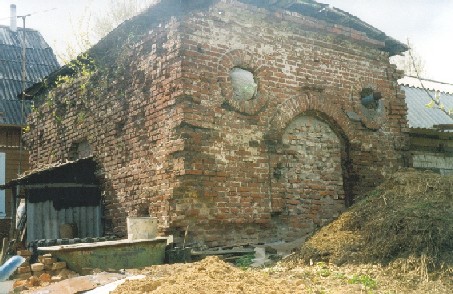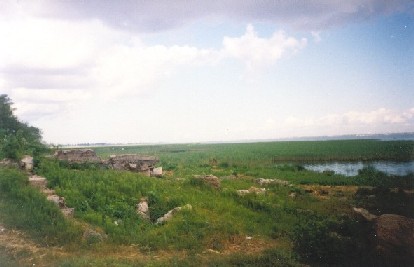4
For the coastal grounds long since belonging Russia, frequent wars were conducted. On Stolbovskomu to the peace treaty concluded in February, 1617 between Russia and Sweden, all the grounds between Narva and Volkhov have been conceded to Sweden and have got the new name - Ingermanlandija. Heavy duties and podati, national and religious oppression compelled Russian population to leave remained under authority of Swedes native places. With the purpose of settling of the become empty edge the Swedish government began to move in Ingermanlandiju.
During this period in 1642 nearby to a cemetery it has been constructed wooden kirha Sacred John. Since this moment on a cemetery at road Koporskoj began to bury people of lutheran belief. The cemetery has been located to the east from a building kirhi and borrowed the small area (approximately 50 x 50 meters).
On this cemetery there was family platform SHtakelbergov. It was surrounded with a stone wall in height about three meters inside of which coniferous trees have been planted. Possibly, here the first has been buried Peterhof "myznik" Swede Charles Arnander.
The Cemetery has been closed in the middle XVIII centuries when kirha it has been transferred approximately on a place of present houses № 5 - 7 on the Deadlock lane.
Construction new kirhi has been completed in 1749, and at once near to it the new cemetery has started to be formed. It was between the Deadlock lane and Field street. A.N.Benua has named this cemetery " rare for the Petersburg surburbs dikovinkoj ". Owing to its memoirs we learn about existence here two mysterious crypts, the deprived inscriptions.
 |
One of them was from a red brick with a high baroque pediment, the black door fettered by iron and two round windows on a facade. Archival documents testify to deliveries in May-June, 1758 of a brick, iron and a tile " to business in Martyshkine a crypt ". And in the beginning of June of the same year under the order of grand duke Peter Fedorovicha in Martyshkino from Petersburg the body certain Brouna for which, apparently, and the construction intended has been transported 1.
|
Soon after revolution the crypt has been opened with the purpose of a robbery. Only in 1926 the crypt was surveyed with expedition of Russian museum. Under fragments the body in clothes of the pastor, a coffin with remains of the militarian in the form of XVIII century and two female mummies was revealed. Names pogrebennyh to establish it was not possible. Bodies have been sent in the Leningrad museum of public health services. Now female mummies are in a museum of sanitary and hygiene, and the mummy of the militarian is transported in Kievo-Pechorskaya laura.
At podnozhja crypt Brouna there was a small stone arch. It is a crypt general-lieutenant A.B.Foka (1763-1825), the descendant golshtinskogo the officer. It participated in the Russian-Swedish war 1788-1790 g.g., in 1812 was the chief of a staff of case Shtejngelja operated under Rigoju and Polotsk.
|
The second mysterious crypt has been located in depth of a cemetery and has been executed from tesanogo a stone in the form of the pyramid leaned a columns which have plunged the ground doricheskogo of an award. On corners there were four vases with falling draperies. A.N.Benua recollects about epitafii, was on a black board of a crypt. On it word only written on Latin "martyrs" was kept, that already, according to Benua, should " aggravate curiosity excessively ". It assumed, that in a crypt could be buried |
On this cemetery Ivan Filippovich Bek (1735-1811), the physician, the doctor of medicine and surgery, the privy councillor have been buried
1.
Here in 1834 the wife N.S.Mordvinova's Genrietta Aleksandrovna Koblej column, anglichanka by origin is buried. Around of its tomb trees from mordvinovskogo park have been planted and the flower bed is broken 3.
In 1921 in connection with limitation of the area a cemetery have closed. After Great Domestic war its territory have built up with individual apartment houses in which bases tombstones
have laid down. Till now people living here, digging up kitchen gardens, find details of sepulchral fencings. The original monument to a cemetery can be named lost pediment " crypt Brouna ", being on territory of the ground area of the house № 5 on Tupikovaya street.
In 20th years
XVIII centuries under project SHarlemanja I was it is constructed stone kirha (the modern address - street Kirochnaja, n.14). After closing a cemetery at Field street of a burial place began to be spent more close to church, in the middle of a cemetery existing nowadays, to the north from Sea street. Buried not only inhabitants Martyshkino, but also from the nearest Finnish villages Greater and Small Iliki, 4.
In Martyshkino was two orthodox cemeteries. The first was opposite to houses № 62 - 66 on Sea street. On other party of road there was a wooden church of Divine Mother constructed in 1884 " Satisfy mine griefs " with the wonderful icon of Divine Mother sent from Athos in honour of which the temple
has been consecrated. Arrival has been closed in 1930. The building was kept till 70th years XX .
On the second orthodox cemetery have started to bury in second half XIX centuries. It settled down opposite to a manor column Mordvinova, near to a lutheran cemetery. The history of these two cemeteries is closely connected with the events occuring in Russia in 1930th years. In connection with the antireligious policy spent by the Soviet government, and deterioration of the Finnish attitudes in first half 1930th years arrival Tjure has been closed. According to local .
 |
Also in Martyshkino there was a German cemetery. Settlements of Germans-colonists have appeared in the beginning XIX centuries under the decree of the Senate signed by Alexander I . So there was Kronshtadskaja a colony where German land owners should organize an indicative facilities. Similar colonies were placed between Martyshkino and Old Peterhof, a number with Strelnoj 5. |
The cemetery has been created in the first quarter XIX centuries and was opposite to houses № 90 - 92 on Sea street. Here made burial places of Germans-colonists from Peterhof, Oranienbaumskoj and Kronshtadskoj colonies. The cemetery function till 1932. After Great Domestic war a cemetery have leveled the bulldozer and in its territory country sites
Within Great Domestic war Martyshkino it has appeared at the advanced front line. It was constantly fired by fascists. This microdistrict takes a special place because here already within war there was the memorial complex divided by highway St.-Petersburg - Lomonosov on two parts - northern and southern.
Northern party of a brotherly cemetery is located on southern surburb of a city civil cemetery. The burial place has started to be formed by the 50 x 50 см.
All a construction of a burial place which became a basis of all memorial complex in east part of city of Lomonosov, were made under the project of architects A.I.Alymova, A.V.Karagina and sculptor Abovjana. Since 1983 the southern part of a memorial became a place of solemn certificates of memory in days of lifting of a blockade and Day of the Victory
4.
End.
Start
Introdute
Main part
Literature
Studying of history, comprehension of the past do an inner world of the person interesting and versatile. If to live without the past it becomes empty and lifeless. I am deeply convinced, that spiritual revival of Russian people cannot be presented without knowledge of the past.
absolutely fairly spoke D.S.Lihachev: " … the person is brought up with history, the past. The past opens to it a window in the world, and not only a window, but also doors, even a gate. To live there where lived
Martyshkino it is often lost before St.-Petersburg, city of fountains - Petrodvorets. However all this a single whole, also should not be separated from each other. The history of the big city of St.-Petersburg is a history of everything that surrounds it on a geographical card that is connected with its development. Therefore, I consider important studying of history of small cities, settlements to which concerns and Martyshkino.
Literature.
Start
Introdute
Main part
End
- Gorbatenko S.B. " the Peterhof road. Oranienbaumsky a history-landscape complex ". SPb, 2001.
- Historic-statistical data on the St.-Petersburg diocese. An extract
X, 1885.
- Parahuda Century the Newspaper " the Baltic beam ".
- Plaksin A.A.card file "Cemetery". Archive of a study of local lore museum of Lomonosov.
- Terentyev "About of Martishkino".
Start


